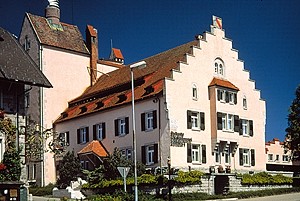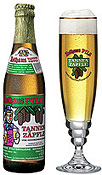Durham on Forbes list
March 12th, 2007Durham is supposedly number 8 of the best places to live in the US:
Yay, Durham – the birthplace of … uh … [CTRL]+[ALT]+[Delete]!??
Durham is supposedly number 8 of the best places to live in the US:
Yay, Durham – the birthplace of … uh … [CTRL]+[ALT]+[Delete]!??
 In 1947, Ghana was the first nation in sub-Saharan Africa to shake the yoke of colonialism and take its destiny in it’s own hands. It joined a group of only seven other, independent African nations: Ethiopia, Liberia, Libya, Morocco, the Sudan, Tunisia, and Egypt (then known as the United Arab Republic). In 50 years of independence this vibrant nation has seen ups and downs, coups and counter-coups, but also long periods of political and economic stability. Today, this stronghold of Pan Africanism is a country permeated by a particular sense of independence and pride in its heritage. In the last 15 years, Ghana has had free elections and a peaceful government transition from Jerry Rawlings to John Kufuor. Ghana is far from perfect. But today this diverse nation is a hopeful example and a beachhead for democracy in West Africa.
In 1947, Ghana was the first nation in sub-Saharan Africa to shake the yoke of colonialism and take its destiny in it’s own hands. It joined a group of only seven other, independent African nations: Ethiopia, Liberia, Libya, Morocco, the Sudan, Tunisia, and Egypt (then known as the United Arab Republic). In 50 years of independence this vibrant nation has seen ups and downs, coups and counter-coups, but also long periods of political and economic stability. Today, this stronghold of Pan Africanism is a country permeated by a particular sense of independence and pride in its heritage. In the last 15 years, Ghana has had free elections and a peaceful government transition from Jerry Rawlings to John Kufuor. Ghana is far from perfect. But today this diverse nation is a hopeful example and a beachhead for democracy in West Africa.
Happy Birthday, Ghana!
[update 3/7: pictures of the parade and a report of Kufuors’ speech]
… accidentally. In the night from Wednesday to Thursday, 170 armed Swiss troops crossed into the tiny neighboring Principality of Liechtenstein. They got lost in bad weather in the Alps during a training exercise and strayed a mile into the unarmed principalities sovereign territory. Scrambling to prevent any escalation, both countries immediately launched diplomatic efforts and were able to peacefully resolve this incident.
Oh boy – that was a close one! :)
BTW: Liechtenstein is the only country left with direct historical continuity back to the Holy Roman Empire of the German Nation (The First Reich).
The other day Marc posted a message to the BIG list with a link to an article that is quite critical of the biofuels industry, and a good example of some of the one-sided thinking of the critics of biofuels.
THE REAL SCOOP ON BIOFUELS
“Green Energy” Panacea or Just the Latest Hype?by Brian Tokar, WW4 REPORT
You can hardly open up a major newspaper or national magazine these days without encountering the latest hype about biofuels, and how they’re going to save oil, reduce pollution and prevent climate change. Bill Gates, Sun Microsystems’ Vinod Khosla, and other major venture capitalists are investing millions in new biofuel production, whether in the form of ethanol, mainly derived from corn in the US today; or biodiesel, mainly from soybeans and canola seed. It’s virtually a “modern day gold rush,” as described by the New York Times, paraphrasing the chief executive of Cargill, one of the main benefactors of increased subsidies to agribusiness and tax credits to refiners for the purpose of encouraging biofuel production. (MORE)
For the most part, this article trots out the usual caveats of the biofuels industry and it is hard to argue against the argument that there is not significant hype and profiteering going on in this industry.
However, I find it odd that they choose to so unequivocally slam biofuels, as they tout the site as a resource for information about what they call World War 4 (clearly, the site is a hype-free zone!). A major factor of most major, current conflicts around the globe is access to fossil oil reserves or control of transit routes for oil and oil products (Iraq, Darfur, Chechnya, Afghanistan).
While the issues of competing food/fuel production, land use, agro-pollution and energy balances are real, and quite relevant, the article frames biofuels in the tired hype-or-panacea dichotomy. This is an overly simplistic view and intellectual laziness. No, biofuels are not a panacea. No, soy and corn will not take care of all of the world’s fuel needs. That does not mean biofuels are not worth pursueing! There is a lot of work to be done to make biofuels a a truly viable alternative for fossil fuels, especially in the big picture. But we have to start now, and we can. The power of this technology is that it is simple, and it is easily accessible.
What irks me most, though, is the point at the end of the article, that argues that conservation is the panacea for all the world’s energy needs, and that no one pushes for greater energy efficiency because there is no profit in conservation. First of all, there is a huge overlap between the alt. fuels folks and the conservation community. Most biodieselers I know also drive very fuel-efficient VWs, not Hummers. I find it offensive that the author of the article seems to suggest that the biofuels community just wants to switch to biofuels, and not make adjustments to achieve greater efficiency.
Second, I think as energy cost rises, thee are excellent commercial opportunities in conservation. The Toyota Prius is a great example. And gasoline-electric hybrid cars are certainly not a panacea to the world’s energy needs, but that does not mean conservation does not work, does it?
Lots of stuff is brewing. I started a Mr Brew keg – 2 gallons of Märzen – I am very curious how that’s going to turn out. I also have 50 gallons of biodiesel settling in the basement. I am running low on methanol – need to make a run to the Roxboro Dragway for some “racing alky.”
Today, I went to the Piedmont board meeting. Lots going on there, too. Among many other things., we’re getting ready for the annual membership meeting in April. We’re planning to move the Bull City Biodiesel tank – the juicebox – to a new location on Angier Ave.
The Africa trip we had planned for June won’t happen. The person who was coordinating the Ghana stuff for Laura’s store is seriously ill and in the hospital. So Laura had to cancel the trip. So now we’re trying to figure out whether we should go by ourselves in the fall.
Friday, I got a growler of the latest brew from Foothills – the Sexual Chocolate Stout. It’s a seasonal brew, and they don’t even list it on their website. But this is a truly amazing beer. It is malty and thick and pitch-black, and it coats the glass when you pour it. I find the flavor to be more mocha and cocoa, not so much chocolate-sweet (like Youngs Double Chocolate Stout). And boy, is it intense! You can taste the almost 10 percent alcohol a bit, but only enough to serve as a discreet warning. What a brew!
Jean-Sylvanus Olympio, the founder and CEO of the consulting firm Consultencia, won a prestigious French entrepreneurship award earlier this month in Paris. The chief geek himself, Bill Gates, handed the Master de la Création 2007 award to Olympio at the Salon des Entrepreneurs conference in front of 6000 people.
Video of the ceremony (via Togocity)
Video of an interview with Olympio after he received the award (via Le Togolais)
So who is Jean-Sylvanus Olympio? Clearly he is Togolese, and he bears a rather famous name: Sylvanus Olympio was the first president of Togo and he was asassinated in 1963 by Gnassinbé Eyadema, the father of the current president. Olympio’s son, Gilchrist is a prominent opposition leader. He tried to run for president several times, but he was bumped out of the race by the RPT on technicalities. It sounds like Jean-Sylvanus Olympio might be a son of Gilchrist and a grand-son of the first president. There is some speculatioin to that effect in the discussion of the Togocity story. I’ll keep digging to see if that is confirmed.
Our local paper, the News & Observer, ran a story today about the status of alternative fuels in the Triangle area and yours truly is mentioned as one of the local “biodiesel nuts” :) … I wish Bull City Biodiesel got a bit more credit for providing 1000 gallons of biodiesel a month to Durham. But at least Piedmont gets good exposure.
Fill-up stations offering a mix of petroleum and high amounts of ethanol, fuel from fermented plant material, can be hard to find. Biodiesels — fuels made from plant and animal fats sometimes, mixed with petroleum — are scattered here and there, known mainly to devotees. One provider of nearly pure biodiesel has a limited number of pump stations accessible only at set hours and only to members of a cooperative.
A few people, including Jurgen Henn, have succeeded in driving off the gasoline grid entirely.
Once a week, Henn walks from his Duke University office in Durham’s Brightleaf District to collect plastic jugs of used cooking oil that three local restaurants save for him.
In his basement at home in Bahama, Henn blends methanol and potash with the discarded grease in a biodiesel reactor built with plumbing parts and a water heater. When his diesel Volkswagen Jetta runs low on fuel, he just pours in his home brew.
“I try to limit the amount of fossil fuel I use. We need to save that stuff as much as we can for our kids and for their kids,” said Henn, a Duke University computer network specialist.
Others buy their biodiesel from a local manufacturer, the Piedmont Biofuels Cooperative. Beth Grabowski, an art professor at UNC-Chapel Hill, is one of 400 members of the co-op. She fills her car with 99.9 percent petroleum-free biodiesel at a pump on Carrboro Public Works property, one of seven co-op pumps in the Triangle. The fuel comes from a reactor the co-op runs in Chatham County that now produces about 1 million gallons of biodiesel a year.
Triangle’s fuel choices are few, News & Observer, Feb 22, 2007
This weekend, I finally tried out my Mr Beer homebrew. I patiently waited 4 weeks for this stuff, and I was rewarded with a rather tasty brew. I let it sit in the barrel a week longer than prescribed, because it had not yet begun to clear up a the end of the first week. After another week, it was so clear that I could see the yeast gunk at the bottom of the little barrel. I bottled the beer in 1-liter pop-top bottles for aging and carbonation. After another two weeks, I popped one open, and behold: the beer poured a lovely clear yellow with lively carbonation and a reasonably firm head. It’s a light-bodied beer with a bit of citrus and a good bit of yeast (stronger from the bottom of the barrel). Nothing fancy, but not bad for a first go at it.
Now, clearly its a “kit beer” and not made from scratch. Basically, the wort comes in a can, and you just warm it up, add sugar and yeast and bubble, bubble … you have beer. Yet, for a first shot at homebrewing, this is not a bad idea. It’s real easy, and it gives the novice a sense of the process, and a sense of accomplishment when it works. After a couple of kit batches, I think I’ll try my hand at making beer from scratch.
Prosit!
Today began the Year of the Pig in the Chinese lunar calendar. Apparently this is considered a very auspicious sign in the Cinese zodiak, and so many Chinese are planing to have a baby this year.
 Last week I undertook a trip to Charlotte, NC, which turned out to be completely for naught. Yet, on my way back to Durham, I took a detour via Winston Salem to have lunch at the Foothills brewery. This little brewery puts out some remarkable brews, and I was quite curious to visit the brewpub to see for myself the place where they produce these fabulous beverages.
Last week I undertook a trip to Charlotte, NC, which turned out to be completely for naught. Yet, on my way back to Durham, I took a detour via Winston Salem to have lunch at the Foothills brewery. This little brewery puts out some remarkable brews, and I was quite curious to visit the brewpub to see for myself the place where they produce these fabulous beverages.
Located on Fourth Street in downtown Winston Salem, the brewpub is nice, with a large bar and modern, open spaces. Nothing fancy, but appealing and straight-forward. The menu is also straight-forward and quite beer-oriented. I had “fish and chips” – and it was really good – and a couple pints of their stout. Very tasty, indeed.
Part of my mission was to refill several growlers for a couple of friends. As I am typing this, I am enjoying a glass of Foothill’s Seeing Double IPA – which is my favorite. It’s a very hoppy strong beer – a prime example of a ridiculously overhopped American ale :) with serious kick at 9.5 percent Alcohol. Somehow they manage to make this into an immensely drinkable beer, with a really smooth mouthfeel and pronounced citrus notes.
The thing about Foothills is that they don’t bottle their beers. So you can only get it on tap at some bars around the state. If you want to enjoy the beers at home, you have to get a growler, which is a half-gallon (2 Liter) bottle that is filled at the tap. The growlers are not pressureized, so you cannot keep them for more than a few days. Once you open one, you better finish it up, or the stuff goes flat. So far, that has not caused me any particular problems.
So when I left the brewery with my five growlers, and headed back to Durham, I felt again at peace with the world, despite the futility of my trip to Charlotte.
Whoopee – isn’t it amazing when stuff just works??!! Upgraded to the latest version of WordPress in a few Minutes. I also added the calendar plugin (see on the sidebar at the top). maybe that’ll be useful.
Since I received my greencard ten years ago, I had very little interaction with the US immigration services – basically I showed my greencard to the friendly officers at the airport once in a while. So when my greencard was about to expire, I requested a new one. I payed the $270 (!) fee and got a date to go to Charlotte for a “biometrics” appointment. That date was last Thursday, but due to the winter weather we had, I missed the appointment. So I called the toll free number on the form to find out how to reschedule the appointment. Thus began my little CIS odyssey.
For work I do call customer support phone lines quite frequently, and so I think I’ve see the Good, the Bad and the Ugly when it comes to automated phone systems. So I thought. The US CIS automated phone system is in an wholly separate category. It has layers upon layers upon layers of “options”
if we approved your I-129 petition and you need us to notify a different POE, please press 6
It took me 20 Minutes to “find” a live person in that maze of Orwellian bureaucrat-speak. I explained my situation and she said that that’s no problem – I should just go to Charlotte on a Wednesday, when they take walk-ins for greencard renewals. Oki-doki.
So today I drove to Charlotte, which is about a 2.5-hour drive. I got there at 11:00 AM – the place was really busy. I explained my situation to the security person at the front desk, and she looked at me and said “You called the 800-number, eh? They don’t know what they are talking about. We have not done walk-ins here in years.” Say what??!!
She explained that after 9/11 they began doing full background checks during the biometrics appointment. That takes 2 hours, or more, so they can’t do more than a few applications a day, let alone walk-ins. Oh great! She said I could wait until 2:00 and see if they have time today. Or I could come back Saturday, and try it again – Saturdays are sometimes less busy.
So why do the people at the call center tell us bogus information? I wondered … The CIS security person said that “they ” tried to get the call center people to stop telling people about walk-ins – to no avail. Uh-huh … So what is the real secret for getting a new appointment? Could you give me a phone number for someone who can reschedule my appointment? Sorry … she said, we’re not permitted to give out phone numbers. The proper way to reschedule is to check a box on the form that says “check here to reschedule the appointment” and mail a copy of the form to CIS.
That’s right – even though I was at the office, my only reasonable option was to mail in the form. That is the type of service the US government provides for a $270 fee, at the beginning of the 21st century!! But we are just damn foreigners – so who cares. Since we don’t get to vote, no one cares. I have no congressman to call about nonsense like that. Yet, we do have the privilege to pay taxes.
Taxation without representation is tyranny
James Otis, American Patriot.
Of course, in comparison to what some people have to go through dealing with CIS, my problems are really pretty minor. So minor, I can actually laugh it off and shake my head at the absurdity of this experience. But this experience also reminds me of the abyss of how such gross inefficiencies of an uncaring bureaucracy can completely ruin lives. And they do. Every day.
Last night it was freeeezing – the low was 10.9 °F / -11.7 °C. Big OOOPS! I did not add more petro diesel to the blend in the fuel tank in my car and the dam juice gelled up. I was worried about it, but when the car started I thought I was good … well, a couple of miles down the road the engine stalled and died.
So I had to call AAA and they sent a tow truck. I had it towed to my trusted mechanic in town, where they parked the car in the heated garage. Then I walked to work from there. Later, they bled the fuel lines and got the air out, and it cranked up just fine. I also added some petro, but tonight it’s not going to be as cold as last night. Just below freezing. The mechanic actually had two other stranded biodieselers in the shop today … oh boy.
 On Feb. 5, 2005, the Republic of Togo was thrown into turmoil when its ruler of 38 years, Gnassingbé Eyadema, unexpectedly died from a heart attack at age 68. His military quickly installed Eyadema’s son, Faure Gnassingbé as the successor of the “old man” – a move quickly denounced by most of the international community. After internal and external pressure, elections were held in April of 2005. Due to substantial intimidation and outright violence and fraud, the ruling RPT claimed victory for its “candidate” Faure. Thus it came to pass that Faure inherited the “family business” from his dad.
On Feb. 5, 2005, the Republic of Togo was thrown into turmoil when its ruler of 38 years, Gnassingbé Eyadema, unexpectedly died from a heart attack at age 68. His military quickly installed Eyadema’s son, Faure Gnassingbé as the successor of the “old man” – a move quickly denounced by most of the international community. After internal and external pressure, elections were held in April of 2005. Due to substantial intimidation and outright violence and fraud, the ruling RPT claimed victory for its “candidate” Faure. Thus it came to pass that Faure inherited the “family business” from his dad.
Now, two years after these dramatic and rather violent events, Togo appears to have changed quite a bit. Under Eyadema’s régime, fear and intimidation were the modus operandus of the public discourse. People who dared to speak out were harassed and often disappeared. Togolese commenting on the situation two years ago in blogs and forums often used pseudonyms and stayed anonymous, for fear of reprisals against their friends and family back home. In Togo, when discussing politics, great care was taken to avoid being overheard easily.
Today, that chill appears to have lifted somewhat. More people are willing to speak out and speak their mind in public. Yet, critics point out(fr) that many of the old power dynamics are still in place, and that much of the perceived liberalization is just window dressing. Interestingly, the official RPT-run government news website touts quite prominently the changes over the last two years, like the de-throning of Rock Gnassinbé from his cushy post as head of the Togolese Football Federation and the installation of prominent opposition figure Yawovi Agboyibo as Prime Minister. Agboybo ran for president twice, and he spent eight months in jail for defaming a former prime minister.
Despite the reformist rhetoric and the new website design, the republicoftogo.com website has hardly become a beacon of free speech and independent political analysis. Rather it is the same RPT rag, just under new management. The mouthpiece of a “kinder, gentler” RPT? Or maybe the RPT just abandoned its hard line approach to further the same basic end: power.
Presenting Faure as a new, pragmatic leader who promises both continuity and a more inclusive leadership is very much in the interest of all the real power brokers in Togo. Clearly, one of the key goals of this maneuvering is to restore economic aid from the European Union. This can only be accomplished with some reforms and acceptable elections. Another key goal for the RPT is to guarantee continuity to the foreign economic interests in Togo (China, France) and to reassure them that their investments are safest with Faure. Finally, France has a vital interest in re-establishing Togo as a pillar of its hegemony in West Africa. That can only be accomplished by maneuvering Togo back into the mainstream of West African politics. France has no interest in Togo as an isolated pariah in West Africa. And the Togolese military has no interest in France loosing interest in buying them new guns.
So is Togo truly changing? Is the RPT turning into a kinder, gentler dictatorship? In some ways it is – and therein does lie a chance for democratization in Togo. Faure is not the old man, he does not command the fear and authority Eyadema did. The RPT is loosening its grip on Togo. Probably for strategic reasons, to present Togo as a new, more enlightened country, in order to get economic aid restored. And finally, Chirac is a lame duck and until a new administration settles in in Paris, the influence of France on West Africa may also be somewhat diminished.
So the election this summer might just represent an opportunity to wrest power from the RPT. That is not a prediction – to be clear – I am not at all sure that the fractured, self-absorbed opposition in Togo has the wherewithall to pull that off. But I do think there may be an opportunity. Theat opportunity is not to legitimize the RPT and the Eyadema clan’s grip on power. It is the opportunity to wrest power from them and to give the Togolese people control over their destiny.
 Congratulations to the German Team Handball Men’s Team! Today they defeated Poland in the final 29:24 (17:13) and won the Worldcup for Germany in Germany!
Congratulations to the German Team Handball Men’s Team! Today they defeated Poland in the final 29:24 (17:13) and won the Worldcup for Germany in Germany!
This is rather amazing – expectations were not very high before the tournament, but the German team really came together and played some amazing handball. And after the football Worldcup last year, the whole country appears to have been swept up by another wave of enthusiasm and cheerful patriotism.
Photo: DPA
This triumph is especially nice, as it brings handball out of the shadow of football, which is the dominant team sport in Germany. Yet handball has deep roots in Germany and it is less corrupted by money and egos that football. It is a great sport and the German players won many more fans for their sport this weekend.
FYI: Team handball, AKA field handball, or European handball is not to be confused with American handball.

The Intergovernmental Panel on Climate Change (IPCC) published its latest report yesterday:
“Climate Change 2007: The Physical Science Basisâ€, assesses the current scientific knowledge of the natural and human drivers of climate change, observed changes in climate, the ability of science to attribute changes to different causes, and projections for future climate change.
The report was produced by some 600 authors from 40 countries. Over 620 expert reviewers and a large number of government reviewers also participated. Representatives from 113 governments reviewed and revised the Summary line-by-line during the course of this week before adopting it and accepting the underlying report.
Bottom line: The Earth is still round, and it’s cooking! Temperatures are rising:
The understanding of anthropogenic warming and cooling influences on climate has improved since the Third Assessment Report (TAR), leading to very high confidence7 that the globally averaged net effect of human activities since 1750 has been one of warming, with a radiative forcing of +1.6 [+0.6 to +2.4] W m-2.
Climate Change 2007: The Physical Science Basis, Summary for Policymakers, page 3.
The Earth is getting warmer and warmer and the thermal expansion of the water and the melting ice are causing the ocean water levels to rise. Most scientists agree that this is real, and really bad news.
Of course the “flat-earth coalition” disagrees. To them, this is all “propaganda” by “… those who want to break the back of the world’s energy system.” Uh-huh … Al Gore would love to see us all in the dark, eating sushi by candle-light and huddling around a fireplace. And of course the fact that Big Oil gave the CEI tons of money has nothing to do with their concern about the threat Al Gore poses to the world’s energy system.
The official Togolese government news website reports that Stephen Keshi is currently in Lom̩. Presumably the ex-coach of the Togolese national football team is talking with the Togolese Football Federation (FTF) about a job. The FTF is now under new management Рits new president Tata was formally installed on Tuesday. A connection between the two events is quite probable.
Keshi, who celebrated his 46th birthday yesterday, coached the Eperviers when they qualified for the Worldcup in Germany last year, but then the team tanked during the African Cup and he was sacked right before the Togo’s first-ever Worldcup appearance. This sparked total chaos for the team and the management during the event and caused an embarrassing performance of the team in Germany – well below its potential. However, much more embarrassing was the inability of the FTF management to deal with the situation constructively.
 Boy – Bill Gates is so not funny! Even Jon Stewart has a hard time being funny with the Ãœber-geek in the studio. “What does the F12 button do?” ??? This is a bit of an awkward interview, especially for Stewart, who is usually pretty good at it.
Boy – Bill Gates is so not funny! Even Jon Stewart has a hard time being funny with the Ãœber-geek in the studio. “What does the F12 button do?” ??? This is a bit of an awkward interview, especially for Stewart, who is usually pretty good at it.
Last night we watched the DVD of Andy Kaufman doing the Midnight Special in 1981. I would give a lot to see Andy Kaufman have Gates on his show. Wow – that would have been just out of this world! Of course Kaufman died in 1984 – way too young – before the age of the geek.
The funniest moment with Gates was when he left without waiting for Stewarts queue …
According to the Togolese government news website, EU officials informed the Togolese ambassador to Belgium this weekend of the lifting of the 14-year-old aid embargo against Togo. The EU decision apparently also prompted the IMF to re-establish relations with the Togolese government – for what that’s worth.
The EU suspended all development aid to Togo in 1993, after President Eyadema’s troops brutally crushed the nascent political opposition to his oppressive military rule. Several thousand Togolese were killed by the military and by RPT death squads during the riots of 1992/93. But all the EU sanctions did was punish a suffering people by undermining Togo’s economy. The deteriorating economy created a massive brain-drain, as many Togolese left for what seemed like greener pastures abroad. That meant that young people with university education left the country, instead of organizing an effective opposition. So suspending aid most likely helped Eyadema, rather than hurt him. If the Europeans really wanted to put pressure on Eyadema, the French should have stopped their military support for the Eyadema regime.
The decision to resume aid to Togo comes after the current “national unity government” was formed last year, based on negotiations facilitated by the government of Burkina Faso. The talks in Ouagadougu resulted in a commitment to hold elections this year, several compromises re the eligibility requirements for presidential candidates, and a coalition government of the ruling RPT and the opposition Union of Forces for Change (UFC).
With Eyadema gone, and the French president Chiraq a “lame duckq,” maybe there is a chance for a democratic election in Togo, after all. If the French keep their sticky fingers OUT of Togo, and the EU and the AU send lots of observers to the polling stations, maybe the seed of democracy can finally sprout in Togo, this year. Still, we’re only talking about legislative elections this year. Extracting the Gnassinbé clan from the presidency and from its stranglehold on Togo will not happen overnight. But if the EU and the AU help the Togolese hold the ruling RPT and the military accountable, maybe there is hope. And a new French president might also help.
… but doesn’t want to. A tale from the Black Forest in Germany.
 Once upon a time, in 1791, to be exact, some Benedictine monks in the Black Forest decided to wean the folks in the nearby village off their beloved Schnapps (brandy). Folks were just drinking too much, and often things got out of hand. They were good people, hardworking mountain folk, who lived a short, harsh life logging, farming and making charcoal, deep in the Black Forest. So the Schnapps they made, their moonshine, was the only distraction, the one thing that made life seem a little less harsh. Yet, they drank too much, and the Schnapps also contributed to the shortness of many a man’s life.
Once upon a time, in 1791, to be exact, some Benedictine monks in the Black Forest decided to wean the folks in the nearby village off their beloved Schnapps (brandy). Folks were just drinking too much, and often things got out of hand. They were good people, hardworking mountain folk, who lived a short, harsh life logging, farming and making charcoal, deep in the Black Forest. So the Schnapps they made, their moonshine, was the only distraction, the one thing that made life seem a little less harsh. Yet, they drank too much, and the Schnapps also contributed to the shortness of many a man’s life.
So the monks decided that their best chance of cutting down the consuption of Schnapps, was to offer a more nutritious beverage: beer. Monks had been brewing in Germany for as long as any one remembered, and it was a natural thing to suggest for these Benidictine brothers. And so they started the brewery “Am Roten Haus” (The Red House) in Grafenhausen. At roughly 1000 Meters (3000 feet) altitude, it is today the highest brewery in Germany. In 1806 , the brewery became the property of the Grand-Dukes of Baden, and after WWI, the brewery was state-owned.

So Rothaus was the mountain beer, and it had (and has) a very provincial image. They have not changed the label design in 30 years! So when I read in the Spiegel Online that Rothaus has become somewhat of a “cult beer,” I almost dropped my laptop. Apparently, about 100 bars in Berlin sell Rothaus beers and it’s the second most popular beer in Cologne. They just cannot brew enough to satisfy demand. And yet, they don’t even advertise aggressively. I mean it’s great beer. The Tannezäpfle is one of the best Pilsener beers in Germany. But it’s not a hip, sexy beer. Its image is downright boring and provincial.
So are the folks at the brewery excited about all this attention? Do they have plans to expand to fill the demand? Come up with a clever marketing strategy? No. They are quite dubious about this. Their little brewery is just fine the way it is – thank you very much.
Actually, the reasoning is more like this: if they expanded they’d have to buld a new brewery in the valley and they would loose the connection with the community of Grafenhausen. They also might loose the image of the little country brewery, which is a big part of the brand appeal to city folk. And the seven springs where they draw the water can only produce so much water – yet the quality of the water is a huge aspect of quality of the final product.
So what to do? Well, it’s really not that big a deal: brew a decent beer, take care of the local market (90 percent of the beer is still consumed within the state of Baden Württemberg), and see if there is some left over for the city slickers up north.
Nome net huodla, gell! Gsundheit!